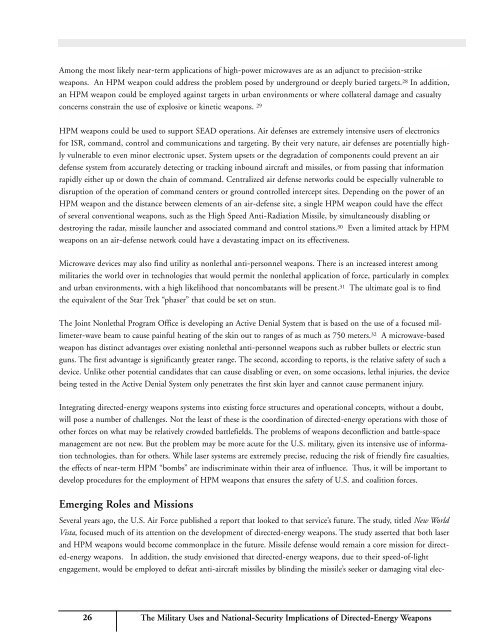directed-energy-weapons
directed-energy-weapons
directed-energy-weapons
Create successful ePaper yourself
Turn your PDF publications into a flip-book with our unique Google optimized e-Paper software.
Among the most likely near-term applications of high-power microwaves are as an adjunct to precision-strike<strong>weapons</strong>. An HPM weapon could address the problem posed by underground or deeply buried targets. 28 In addition,an HPM weapon could be employed against targets in urban environments or where collateral damage and casualtyconcerns constrain the use of explosive or kinetic <strong>weapons</strong>. 29HPM <strong>weapons</strong> could be used to support SEAD operations. Air defenses are extremely intensive users of electronicsfor ISR, command, control and communications and targeting. By their very nature, air defenses are potentially highlyvulnerable to even minor electronic upset. System upsets or the degradation of components could prevent an airdefense system from accurately detecting or tracking inbound aircraft and missiles, or from passing that informationrapidly either up or down the chain of command. Centralized air defense networks could be especially vulnerable todisruption of the operation of command centers or ground controlled intercept sites. Depending on the power of anHPM weapon and the distance between elements of an air-defense site, a single HPM weapon could have the effectof several conventional <strong>weapons</strong>, such as the High Speed Anti-Radiation Missile, by simultaneously disabling ordestroying the radar, missile launcher and associated command and control stations. 30 Even a limited attack by HPM<strong>weapons</strong> on an air-defense network could have a devastating impact on its effectiveness.Microwave devices may also find utility as nonlethal anti-personnel <strong>weapons</strong>. There is an increased interest amongmilitaries the world over in technologies that would permit the nonlethal application of force, particularly in complexand urban environments, with a high likelihood that noncombatants will be present. 31 The ultimate goal is to findthe equivalent of the Star Trek “phaser” that could be set on stun.The Joint Nonlethal Program Office is developing an Active Denial System that is based on the use of a focused millimeter-wavebeam to cause painful heating of the skin out to ranges of as much as 750 meters. 32 A microwave-basedweapon has distinct advantages over existing nonlethal anti-personnel <strong>weapons</strong> such as rubber bullets or electric stunguns. The first advantage is significantly greater range. The second, according to reports, is the relative safety of such adevice. Unlike other potential candidates that can cause disabling or even, on some occasions, lethal injuries, the devicebeing tested in the Active Denial System only penetrates the first skin layer and cannot cause permanent injury.Integrating <strong>directed</strong>-<strong>energy</strong> <strong>weapons</strong> systems into existing force structures and operational concepts, without a doubt,will pose a number of challenges. Not the least of these is the coordination of <strong>directed</strong>-<strong>energy</strong> operations with those ofother forces on what may be relatively crowded battlefields. The problems of <strong>weapons</strong> deconfliction and battle-spacemanagement are not new. But the problem may be more acute for the U.S. military, given its intensive use of informationtechnologies, than for others. While laser systems are extremely precise, reducing the risk of friendly fire casualties,the effects of near-term HPM “bombs” are indiscriminate within their area of influence. Thus, it will be important todevelop procedures for the employment of HPM <strong>weapons</strong> that ensures the safety of U.S. and coalition forces.Emerging Roles and MissionsSeveral years ago, the U.S. Air Force published a report that looked to that service’s future. The study, titled New WorldVista, focused much of its attention on the development of <strong>directed</strong>-<strong>energy</strong> <strong>weapons</strong>. The study asserted that both laserand HPM <strong>weapons</strong> would become commonplace in the future. Missile defense would remain a core mission for <strong>directed</strong>-<strong>energy</strong><strong>weapons</strong>. In addition, the study envisioned that <strong>directed</strong>-<strong>energy</strong> <strong>weapons</strong>, due to their speed-of-lightengagement, would be employed to defeat anti-aircraft missiles by blinding the missile’s seeker or damaging vital elec-26 The Military Uses and National-Security Implications of Directed-Energy Weapons


